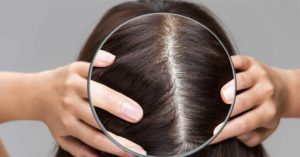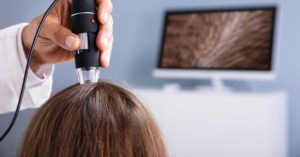
Let’s start with the basics… what exactly makes up the scalp?
What Part of the Head is the Scalp?
As you likely know, the scalp is what covers the top, back, and part of the side of your head. It’s basically everything that isn’t your face or neck. What you may not be aware of is that the scalp is made up of five distinct layers.
The first three of the layers are tightly bound and, more or less, act as a single unit. Those layers are the skin, connective tissue, and epicranial aponeurosis. The skin is where you will find the hair follicles then, below the skin, is the connective tissue directly attaching the skin to the epicranial aponeurosis – which acts as a tendon connecting the muscles from the front and back of the scalp.
Below that we have another layer of connective tissue. This one is looser than the previous layer and allows more mobility. It is important to note that both layers of connective tissue in the scalp are dense with blood vessels, which is (in part) why damage to the scalp can cause profuse bleeding. The final layer, periosteum, is a dense connective tissue connecting the scalp to the skull; serving this purpose from the forehead down the back of the head where it meets the neck.
How Do I Know My Scalp Type?
There are three basic scalp types: Dry, Oily, and Normal.
- Dry Scalps
- Oily Scalps
- Normal scalps
Dry scalps can result in dry, frizzy hair that breaks more easily – as well as a build-up in dry skin on the scalp that comes off in small flakes known as dandruff.
Oily scalps usually leads to acne from clogged up pores as well as dandruff.
Normal scalps (which is more rare) tend to be drier in the winter months and more oily in the summer… maintaining a balance without much need for any particular hair and scalp products.
Why Is My Scalp Oily But My Hair Dry?
It is possible that you may find that your scalp is oily while your hair is dry. Multiple reasons can cause this condition. It may be genetic and will be something that requires extra care. Another possibility is over-washing. Shampoo is supposed to remove excess oil in the hair, but it is possible your scalp is producing excess oil that your shampoo isn’t removing while drying out your hair. You may need to switch shampoos and hair products or consult with a doctor.
RHRLI Can Help Restore Your Hair No Matter Your Scalp Type
Regardless of the kind of scalp you have, my staff and I at Robotic Hair Restoration Long Island are equipped to restore your hairline. Utilizing the ARTAS® Robotic Hair Transplant System, RHRLI can restore your hair whether it is male pattern hair loss or other forms of hair loss including patches of hair lost from an excessively oily scalp damaging the hair follicles.
The procedure is minimally invasive and will allow you to get back to your day-to-day life quickly. Contact us today for a free consultation and make the first step towards restoring your hair and your confidence!

